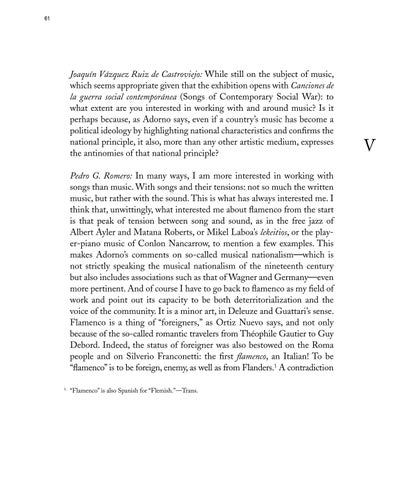61
Joaquín Vázquez Ruiz de Castroviejo: While still on the subject of music, which seems appropriate given that the exhibition opens with Canciones de la guerra social contemporánea (Songs of Contemporary Social War): to what extent are you interested in working with and around music? Is it perhaps because, as Adorno says, even if a country’s music has become a political ideology by highlighting national characteristics and confirms the national principle, it also, more than any other artistic medium, expresses the antinomies of that national principle? Pedro G. Romero: In many ways, I am more interested in working with songs than music. With songs and their tensions: not so much the written music, but rather with the sound. This is what has always interested me. I think that, unwittingly, what interested me about flamenco from the start is that peak of tension between song and sound, as in the free jazz of Albert Ayler and Matana Roberts, or Mikel Laboa’s lekeitios, or the player-piano music of Conlon Nancarrow, to mention a few examples. This makes Adorno’s comments on so-called musical nationalism—which is not strictly speaking the musical nationalism of the nineteenth century but also includes associations such as that of Wagner and Germany—even more pertinent. And of course I have to go back to flamenco as my field of work and point out its capacity to be both deterritorialization and the voice of the community. It is a minor art, in Deleuze and Guattari’s sense. Flamenco is a thing of “foreigners,” as Ortiz Nuevo says, and not only because of the so-called romantic travelers from Théophile Gautier to Guy Debord. Indeed, the status of foreigner was also bestowed on the Roma people and on Silverio Franconetti: the first flamenco, an Italian! To be “flamenco” is to be foreign, enemy, as well as from Flanders.1 A contradiction 1.
“Flamenco” is also Spanish for “Flemish.”—Trans.
V





